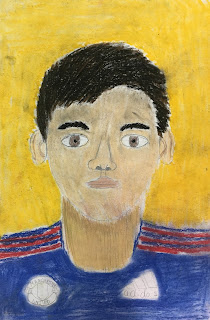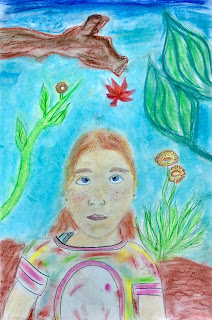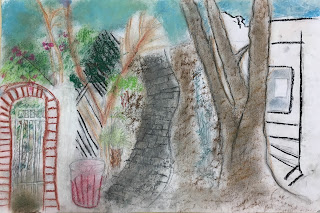 |
| Student example |
I love so many things about this student's artwork. The muted palette (unusual in elementary), the textural quality of her hair, and how engaged she was in faithfully representing herself!
The first major project in 5th grade is to create a self-portrait that communicates something about you - and interest or belief - while practicing accurate proportions and realistic drawing. We start by investigating artists famous for their self-portraits, with particular emphasis on Frida Kahlo and Vincent van Gogh. I always jump at the chance to include female artists, especially from underrepresented cultures in the Western canon so Frida Kahlo is a perfect fit for this project. It also gives me a chance to dress up as Frida at school on Halloween, so there's that too!
 |
| Favorite costume! |
Yes, Frida requires some curation on the part of the teacher but her images are so powerful and thought-provoking. Her self-portraits range from dream-like to political and inspire great conversations about her beliefs and background. Vincent van Gogh is so popular, with an equally compelling background, that he must be mentioned in any conversation about self-portraits. Mike Venezia's Getting To Know The Greatest Artists series does such a good job of touching on van Gogh's biography, painting style, and unhappy demise that keeps students engaged in their learning.
After examining examples from art history, students are ready to tackle human proportions and representing the human body in their artwork. My first year doing this project, I did a directed line drawing of a face with guidelines, tutorials on all of the facial features, and reminders to examine your own face in the self-portrait mirror... over 8 times. It makes my voice and hand feel tired again just thinking about it. This year, I tried sharing a Google Slides presentation with my students through Drive (they all have their own Gmail account) but some kids struggled without the in-the-moment reminders about shape and proportion. It is my goal to create a video of myself drawing a human face in proportion and playing it during class so I can also walk around to provide extra support. Now I just have to pluck up the courage to put myself on camera...
 |
| Student example |
After students have sketched themselves realistically, working out the kinks of where everything goes and how big each feature should be, they move on to style. In the Google Slides presentation I mentioned above, I included slides featuring some other famous self-portraits. Since students had spent a fair bit of time analyzing Kahlo and van Gogh's styles they were able to pick up on the differences in color palette, realism, and proportion. Students were then able to choose a style to inspire their self-portrait if they didn't want to create a strictly realistic representation. The artists they could choose from were: Frida Kahlo, Vincent van Gogh, Henri Matisse, Chuck Close, and Amadeo Modigliani. Then, of course, there were students who wanted to create their own style and I encouraged it as long as they could explain their inspirations.
 |
| Student example |
Last, but not least, students added a background. Like Frida Kahlo, I recommend adding details that communicate an experience, preference, or belief to make the self-portrait meaningful. If the students chose one of the featured artists then they could add a background inspired by their research. Above, the student really took this to heart and did such a great job blending the chalk pastel using color to create contrast and emphasis.
What resources do you use to help students learn proportions and realistically draw faces and people? Any other artists that could be studied for their self-portraits?
Artfully,
Catherine







